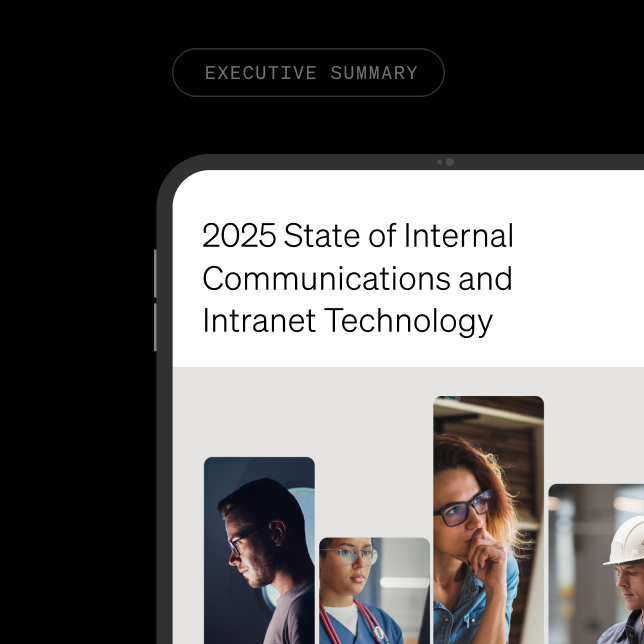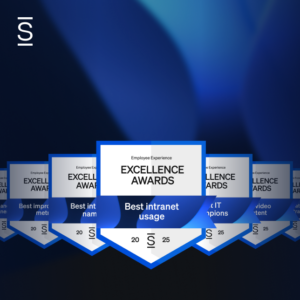At Simpplr, we understand the importance of getting the C-suite involved in internal communications. However, we don’t hear as much about People Managers and what their intended role should be in Internal Communications (IC) efforts. It is something Simpplr, and I feel very passionate about. To help you understand this concept, I would like to share the “why” behind getting people leaders involved is critical to employee experience.
Achieving People Leaders’ Buy-In
I recently implemented an annual awards program. Winning this award was a BIG deal because employees got a substantial bonus and a nice all-expenses-paid trip. Employees anxiously waited to find out who won. However, I went back and forth on who should let employees know they won.
I grappled with the question: Who should be the person to surprise the employee with the news that they won?
My first inclination was that the CEO should do it. How cool would that be? The head of your company and work leader busts in a meeting room along with your family and tells you that you have done a fantastic job over the last year. The CEO then congratulates you for winning and makes a big deal in front of your co-workers. Can you hear the cheering and maybe see a little jealousy in your colleagues’ eyes?
This option made sense to me. It brought the relationship between the CEO and employee closer. In all honesty, most people think the CEO couldn’t pick them out of a line-up. But was it the right decision? I wondered if this was the right strategy because I wanted to affect employees significantly. I wanted them to feel valued and appreciated.
After doing some research, I learned that employees prefer to get this recognition from their managers. That’s when I began to fully grasp the importance People Managers can and should play in internal communications. It is impactful because at the grassroots level, who would know the employee the best? The CEO or their manager?
Value in the Manager-Employee Relationship
There is tremendous value in the relationship between employees and their managers. A Businees.com article titled “How to Improve Relations Between Your Managers and Employees” stated that “Poor relationships in the workplace can directly impact employee performance and retention. If you’re not focusing on employee relations, you could face costly issues.” A key to employee relations is the one between manager and employee. This relationship directly impacts company culture and employee engagement across the company.
There is even an adage that states that “employees don’t leave their jobs, they leave their managers.” In other words, a manager’s relationship will have more impact on the direct report employee than the employee’s relationship with a CEO. Although, there is a symbiosis between the three.
According to an article in Harvard Business Review, researchers Cheri Ostroff and Ashley Fulmer found that “Corporate leaders can improve how credible they seem by focusing on the relationships employees have with their frontline leaders.” Their study published in the Journal of Applied Psychology found that “by focusing on these relationships, senior leaders can improve the degree to which employees in the organization view them. Trust, in other words, trickles up.” When done well, employees put more trust in their manager. When people trust their frontline manager, confidence and credibility “trickle up” to C-suite leaders.
So the good news is that the more the employee trusts their manager, the more they trust the CEO. (Yet another reason to work with People Managers!)
So why is this important to call out?
As noted above, internal communications professionals emphasize getting C-suite leaders involved with employee communications, and rightfully so. However, we may be missing a crucial piece of the puzzle: IC working with People Managers on internal communications.
“Boots on the Ground” of Internal Communications
Think of People Managers as the fundamental grassroots communication channel in your strategy. People Managers are the “boots on the ground” to get your message across the organization. It is easy for employees to tune out the mass messaging channels, like intranet and all-hands. However, they listen to the managers in one-on-one conversations and team meetings. Not every work environment is conducive to the ripe technology that enables corporate communications.
Think about warehouse employees who load trucks with customer packages. Most of them do not use technology to engage with company news and information. They are not given time to check the intranet, read the company newsletter, or attend the all-hands. Their time might be carefully sequenced each day. But they likely have daily or weekly standing meetings with their managers. Perhaps the next phase of product advancement in internal communication software is in this area.
In the meantime, here are some relatively quick and reliable ways to reach People Managers. This content shouldn’t be made from scratch. You can find most of this information in documents and presentations that can be reused and sent to People Managers.
- Quarterly meetings: In these meetings, People Managers will preview the quarterly goals, events, and milestones. This transparency will give People Managers a strategic birds-eye-view on what is to come in the coming months to prepare.
- Intranet site or page: For managers, an Intranet site or page displays essential information they will need to keep their employees in the know.
- A newsletter: This type of communication helps People Managers outline essential information about what’s coming up and what will be asked of the employee. Think of this as the top-five action items for the week (or month) and include links to additional resources on the intranet site.
- Additional resources: These include such items as slides, posters and signage, FAQs, and talking points. This resource will keep managers aligned and singing from the same hymnal. They can use this content for one-on-one meetings, emails to their teams, hang up in common space, and discuss at team meetings.
Keeping these methods and tools in your toolbox will not only help build trust and confidence employees have in managers, but managers will feel more in the know, and employees will get more information. Including People Managers in your strategy is a win-win.















